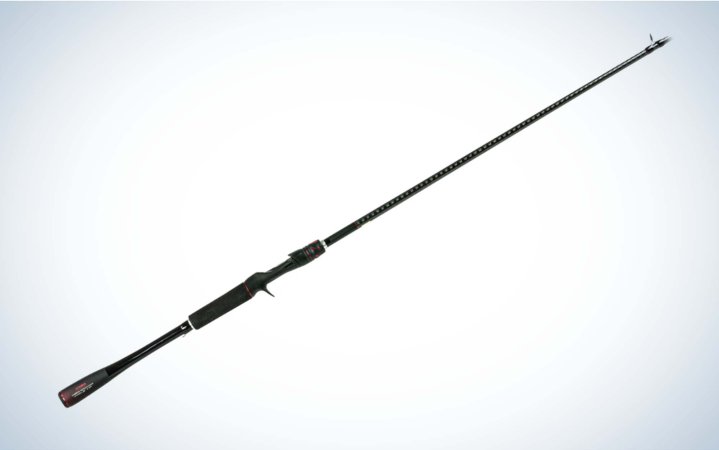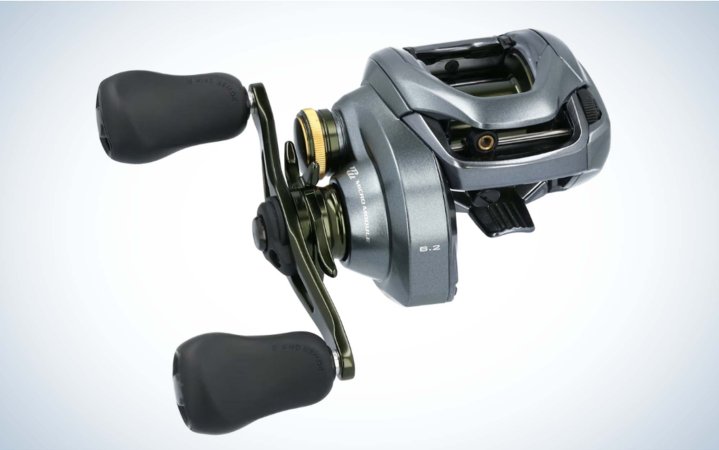We may earn revenue from the products available on this page and participate in affiliate programs. Learn More ›
The free rig is a cross between the ever-popular Texas rig and the seemingly forgotten Carolina rig. As far as bass fishing techniques go, it doesn’t get much hype, but occasionally sees some limelight when an angler wins a tournament using it. It rides in the middle between power fishing and finesse fishing, which makes it such a useful tool to add to your arsenal.
The free rig is deceptively simple. It’s just a bell weight, a hook, and a soft plastic of your choosing. Here’s everything you need to know about fishing a free rig.
The Free Rig
The standard free rig is typically a ⅛- to ⅜-ounce bell weight and a 3/0 EWG hook with a soft plastic, usually a worm. But the free rig isn’t all that standard. Since it lives somewhere between power fishing and finesse fishing, you can use it to do both.
The free rig allows you to choose your weight and bait to fit your needs, practically any needs. Want to drag a crawfish-style bait with a heavy baitcasting setup along the bottom? A free rig can do that. Want to fish underneath sailboats with a lightweight spinning combo when bass are high in the water column? A free rig can do that too. No matter the scenario, you can make a free rig work. Simply match your scenario with the size of bell weight you need and you’re off to the races.
How to Rig a Free Rig

A free rig should take a minute to rig up and be ready to fish with these four steps.
Step 1: Select your bell weight size to match the fall rate you’re looking for. Lighter options will produce slower fall rates, allowing you to catch fish staging higher in the water column.
Step 2: Select your hook of choice. You can really pick any style of hook ranging from EWG’s to offset hooks, or even a straight shank hook if you’ll be flipping the free rig more than casting it.
Step 3: Thread your line through the bell weight and tie on your hook using a Palomar knot.
Step 4: Thread on your soft plastic of choice.
What Makes the Free Rig so Effective?
The free rig fills the gap of a slow-falling, almost-vertical presentation where the bait is separated from the weight. A Texas rig typically doesn’t separate from the weight until it hits the bottom, and a Carolina rig is always separated, but is fished horizontally along the bottom. However, the free rig separates from the weight on the way down and allows the bait to have a unique vertical falling action through the water column.
As the weight is able to move freely up and down the line, the bait is also able to move freely, hence the name.

The versatility of this technique allows it to trick heavily pressured bass because it’s a presentation they rarely, if ever, see. When a technique gains widespread popularity, success dwindles, but the free rig has been able to stay in the shadows. It’s quietly catching bass for a select few anglers who won’t let the cat out of the bag. Those anglers may even send me a nastygram or two for writing about the free rig, but if it helps you catch more fish, then that’s a burden I’ll bear.
To fish this rig successfully, all you really need to do is find areas that hold bass. Whether that’s a grass line, an offshore hump with rock piles, or a current break behind a bridge piling, bass will hold on or near those areas to ambush baitfish. In the case of the free rig, if they’re staging above the cover or high on the structure, they’re ripe for the picking.
As your weight plummets by them, it may even grab their attention. Then your unsuspecting soft plastic will come into view, slowly sinking to the bottom in pursuit of your weight, providing the bass with an easy meal that’s too hard to pass up.
For a deep dive video, check out this great video from my friend TylersReelFishing.

How to Fish a Free Rig
While this finesse technique may seem fairly straightforward, there are actually a few different ways to effectively cover water and get the most action out of your rig. Most finesse techniques aren’t incredibly effective for covering large swaths of water, but thanks to the bell sinker, you can make long casts with a free rig and still maintain control over the bait at the end of your longest cast.
My favorite way to fish this rig is a gentle hopping motion. Similar to how I prefer to fish a Texas rig, this will put a lot of action into your soft plastic and allow the bell sinker to slide up and down the line with each lift of your rod. Another reason I prefer this method is it allows me to consistently check my line, making sure a fish didn’t eat the free rig on the drop.
Another method is to drag your free rig along the bottom. In areas with drop offs, ledges, or varying contour lines, this can be effective at keeping your rig close to the bottom while still allowing the bell sinker to find spots to drop down away from the soft plastic. If you’re fishing in an area with a lot of silt or mud, dragging might not be the best option though as it’ll be tough for the weight to really separate from the bait.
Finally, if you’re fishing for incredibly aggressive bass, you can add a lot of action to your free rig by using big long pulls with pops mixed in. This can sometimes be the perfect pairing of the above options for fishing the rig, but the conditions have to be right for this to be effective.
As with any technique, let the bass tell you what they like. If you seem to be getting more bites with gentle hops, stick to that. Don’t add more action unless you have to.
When to Throw a Free Rig
Picking the right time to throw this rig is simple. Since you’ll be fishing it in similar locations to where you’d fish a Texas Rig or a Carolina rig, you’re waiting for the same time of year as well. The early summer is primetime, but it will work through the dog days of summer and into the fall.
I like to throw a free rig when a light wind breaks up the surface, but not so much wind that I can’t maintain contact with the bait to feel the bites. Since I typically fish it more as a finesse technique, I prefer lighter lines and smaller weights, which are not ideal in heavy wind.

When the conditions are right in the early summer, you’ll want to throw it anywhere bass are staging to ambush their prey. Since most of the bass have entered their summer patterns by now, you’ll likely find the majority on offshore structure and cover with deep water access nearby. Whether that’s a rocky hump with some stumps on it, or just a deep grassline, the bass will prefer these areas.
Once you locate these offshore honey holes, simply rig up your free rig and let it fly. If you find that you’re not getting enough bites, experiment with your bait selection or color selection. Bass can get pretty finicky in the summer, so a purple or orange fleck can make all the difference.
The Gear You Need to Rig and Fish a Free Rig
Picking the Right Free Rig Rod
Any time you’re faced with selecting the right rod for a super versatile technique, there’s not just one good pick. That said, I’ll recommend the rod and other gear that I prefer for throwing a free rig as a more finesse tactic. But if you’re more into power fishing, beef up the gear I recommend.
I mostly throw light free rig weights, so I use a lighter action casting rod. My go-to casting rod for a free rig is the Shimano Zodias. I like to use a 7-foot 2-inch, medium-power rod with a moderate fast tip. That rod allows me to get more casting distance out of the free rig, and the moderate fast tip lets me feel the difference between the weight hitting the bottom and a bass biting the lure.
Picking the Right Free Rig Reel
When selecting the right reel for a free rig, you’re going to want something with a high-quality drag. As you fight a fish on a free rig, the weight can actually be a hindrance, allowing the fish to gain leverage as the weight moves on the line during the fight. Ideally, it stays pegged near the hook, but things rarely go to plan. With that in mind, I lean on the Shimano Curado DC in a 7.4:1 gear ratio. The reel offers an awesome drag system that helps keep the bass pegged, and the digital control braking technology makes it easy to throw lightweight free rigs with ease.
The Best Free Rig Baits
Practically any soft plastic can work with a free rig. Similar to a Texas rig, you can use stick baits, creature baits, or worms. The biggest thing I’ve found helpful is picking soft plastic lures that displace more water while they sink. This will help slow the soft plastic as it falls, allowing the weight to hit the bottom and the soft plastic to really slowly shimmy through the water column. My go-to bait for this is a paddle tail worm from Lake Fork Trophy Lures called the Hyper Worm. The Hyper Worm has some awesome action as it falls, and the paddle tail displaces lots of water as it sinks. Another great option is the X Zone Lures Pro Series Adrenaline Craw. The Adrenaline Craw features floating claws that slow the bait’s descent through the water column, triggering any bass nearby into biting.
The Best Free Rig Hooks and Weights
The hook you decide to use will come down to personal preference. As I mentioned before, you can use EWG’s, offset hooks, or even straight shank hooks. For my own personal use, I typically use 2/0 Eagle Claw TroKar EWG worm hooks.
As for the weights, any bell weight will do, but I like to throw the Bass Pro Shops Bass Casting Sinkers. They come in a wide variety of weights from ⅛ ounce up to 4 ounces. However, if you find yourself lacking in bell weights, don’t fret. You can very easily modify any drop shot weight you have to serve your free rig needs. Simply open up the line tie with a pair of split-ring pliers so the weight can freely move up and down your line.
Line for Free Rigs
When it comes time to spool up your free rigging baitcasting reel, look no further than 12-pound Sunline Super FC Sniper Fluorocarbon Line. The fluorocarbon line will be the best option for your free rig because it slowly sinks, helping the action of your bait as it falls through the water column.
Final Thoughts and Tips on How to Fish a Free Rig
It never hurts to learn a new technique, let alone a technique that many anglers don’t tie up for one reason or another. The less bass see a certain presentation, the more likely they are to eat your lure. I’ve found a lot of recent success while throwing the free rig, and I don’t think that success is going to slow down anytime soon.
This versatile technique deserves your attention, and I’d be willing to bet that you won’t be disappointed in the results after tying it up. Throw your favorite soft plastic on there, or try something different and see how it goes.



